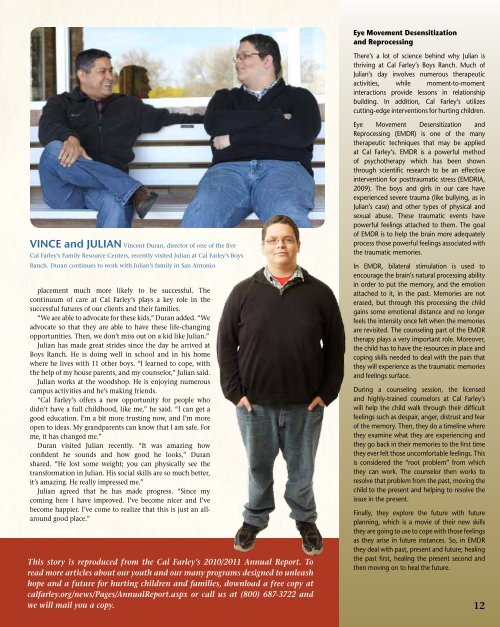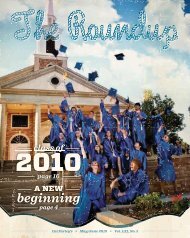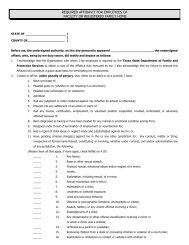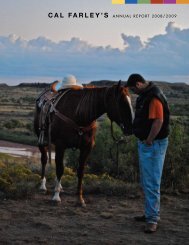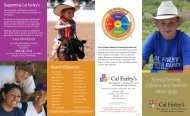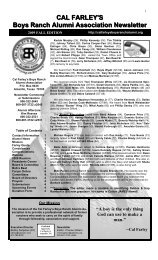The Roundup Summer 2012 - Cal Farley's
The Roundup Summer 2012 - Cal Farley's
The Roundup Summer 2012 - Cal Farley's
Create successful ePaper yourself
Turn your PDF publications into a flip-book with our unique Google optimized e-Paper software.
Eye Movement Desensitizationand Reprocessing<strong>The</strong>re’s a lot of science behind why Julian isthriving at <strong>Cal</strong> Farley’s Boys Ranch. Much ofJulian’s day involves numerous therapeuticactivities, while moment-to-momentinteractions provide lessons in relationshipbuilding. In addition, <strong>Cal</strong> Farley’s utilizescutting-edge interventions for hurting children.VINCE and JULIAN Vincent Duran, director of one of the five<strong>Cal</strong> Farley’s Family Resource Centers, recently visited Julian at <strong>Cal</strong> Farley’s BoysRanch. Duran continues to work with Julian’s family in San Antonio.placement much more likely to be successful. <strong>The</strong>continuum of care at <strong>Cal</strong> Farley’s plays a key role in thesuccessful futures of our clients and their families.“We are able to advocate for these kids,” Duran added. “Weadvocate so that they are able to have these life-changingopportunities. <strong>The</strong>n, we don’t miss out on a kid like Julian.”Julian has made great strides since the day he arrived atBoys Ranch. He is doing well in school and in his homewhere he lives with 11 other boys. “I learned to cope, withthe help of my house parents, and my counselor,” Julian said.Julian works at the woodshop. He is enjoying numerouscampus activities and he’s making friends.“<strong>Cal</strong> Farley’s offers a new opportunity for people whodidn’t have a full childhood, like me,” he said. “I can get agood education. I’m a bit more trusting now, and I’m moreopen to ideas. My grandparents can know that I am safe. Forme, it has changed me.”Duran visited Julian recently. “It was amazing howconfident he sounds and how good he looks,” Duranshared. “He lost some weight; you can physically see thetransformation in Julian. His social skills are so much better,it’s amazing. He really impressed me.”Julian agreed that he has made progress. “Since mycoming here I have improved. I’ve become nicer and I’vebecome happier. I’ve come to realize that this is just an allaroundgood place.”This story is reproduced from the <strong>Cal</strong> Farley’s 2010/2011 Annual Report. Toread more articles about our youth and our many programs designed to unleashhope and a future for hurting children and families, download a free copy atcalfarley.org/news/Pages/AnnualReport.aspx or call us at (800) 687-3722 andwe will mail you a copy.Eye Movement Desensitization andReprocessing (EMDR) is one of the manytherapeutic techniques that may be appliedat <strong>Cal</strong> Farley’s. EMDR is a powerful methodof psychotherapy which has been shownthrough scientific research to be an effectiveintervention for posttraumatic stress (EMDRIA,2009). <strong>The</strong> boys and girls in our care haveexperienced severe trauma (like bullying, as inJulian’s case) and other types of physical andsexual abuse. <strong>The</strong>se traumatic events havepowerful feelings attached to them. <strong>The</strong> goalof EMDR is to help the brain more adequatelyprocess those powerful feelings associated withthe traumatic memories.In EMDR, bilateral stimulation is used toencourage the brain’s natural processing abilityin order to put the memory, and the emotionattached to it, in the past. Memories are noterased, but through this processing the childgains some emotional distance and no longerfeels the intensity once felt when the memoriesare revisited. <strong>The</strong> counseling part of the EMDRtherapy plays a very important role. Moreover,the child has to have the resources in place andcoping skills needed to deal with the pain thatthey will experience as the traumatic memoriesand feelings surface.During a counseling session, the licensedand highly-trained counselors at <strong>Cal</strong> Farley’swill help the child walk through their difficultfeelings such as despair, anger, distrust and fearof the memory. <strong>The</strong>n, they do a timeline wherethey examine what they are experiencing andthey go back in their memories to the first timethey ever felt those uncomfortable feelings. Thisis considered the “root problem” from whichthey can work. <strong>The</strong> counselor then works toresolve that problem from the past, moving thechild to the present and helping to resolve theissue in the present.Finally, they explore the future with futureplanning, which is a movie of their new skillsthey are going to use to cope with those feelingsas they arise in future instances. So, in EMDRthey deal with past, present and future; healingthe past first, healing the present second andthen moving on to heal the future.12


